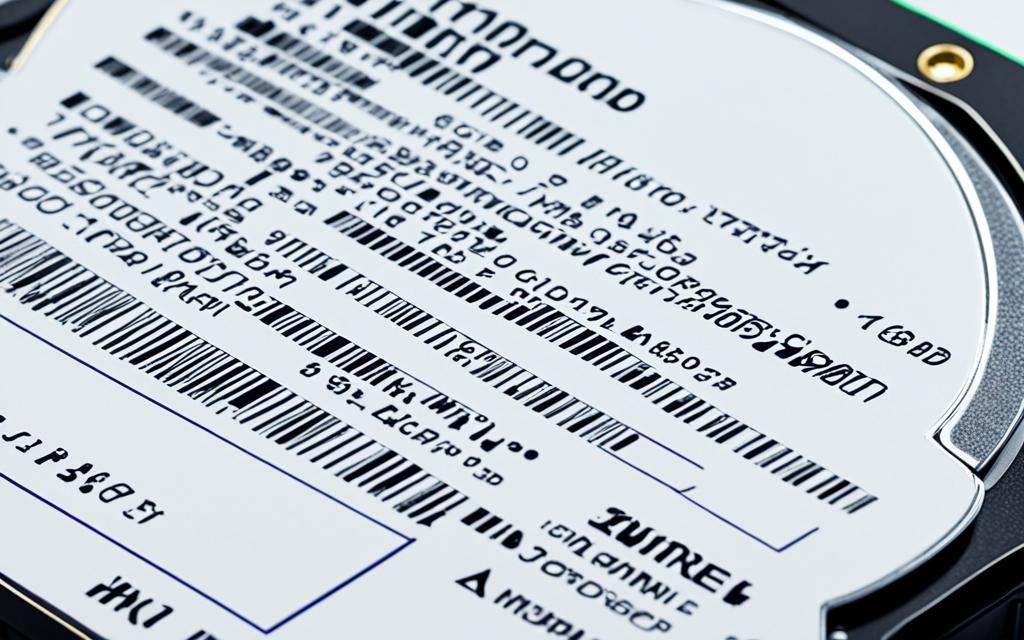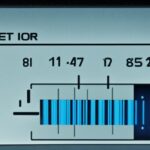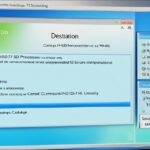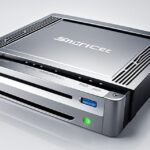Table of Contents
An internal hard disk drive (HDD) is a key part of data storage in the digital world. It keeps information safe even without power. This makes it crucial for a computer’s system, applications, and storing our digital files. We will look into the important roles and types of internal HDDs in computing today.
Internal HDDs are different from external devices. They are not just for backing up data or moving files around. These drives are a central part of a computer’s structure, making everything work smoothly. As we go further, you’ll learn about the parts of an internal HDD. You’ll also see how they compare to external drives. This knowledge will help us get why these technologies are so important.
Understanding internal HDDs helps us choose the best storage solutions. Whether it’s for personal stuff or work-related needs, knowing about these drives is a big advantage. It helps us decide what’s best for our data storage needs.
Key Takeaways
- Internal HDDs are vital for retaining data even when powered off.
- They play an essential role in running operating systems and applications.
- Understanding their components can aid in selecting the right drive for specific needs.
- Internal HDDs differ significantly from external HDDs in purpose and function.
- They can hold vast amounts of digital content, with capacities exceeding 28TB in select models1.
- Upgrading internal HDD offers built-in storage improvements while external HDDs provide portability2.
Introduction to Hard Disk Drives
A hard disk drive, or HDD, is key in our digital lives. It stores lots of data for people and companies. This hard disk drive definition shows its role as a durable storage device. It keeps data safe even when there’s no power. For anyone diving into data storage technology, HDDs are crucial. They hold not just operating systems and apps, but also personal files. This makes them vital for computers to work every day.
Definition and Purpose
HDDs are main storage in many computers. But, some new models use SSDs for better speed3. They connect to the motherboard and power supply, showing they’re essential for computer function3. External HDDs add more storage space via USB or Thunderbolt3. Storage size varies. Some can store up to 20 TB4, and some as little as 16 GB.
Yet, HDDs can be slow at fetching big files compared to SSDs, which are fast and durable35. HDDs have moving parts, leading to more power use and heat3. This has made SSDs more popular for their speed and durability.
Knowing these differences is crucial as technology moves forward. This helps people choose the best storage for their needs. With ongoing changes in data storage technology, HDDs still play a big role. They help keep our digital world alive.
What is Internal HDD?
Understanding what an internal HDD is, it’s vital to know they’re the core of computer data storage. These drives fit inside the computer’s case, connecting directly to the motherboard and power supply. This setup makes internal HDDs crucial for holding important data such as applications, files, and the operating system.
Internal HDDs vary in size, with some reaching up to 28TB6 or 14TB for gamers7. Their reading speeds can go up to 291MB/s1, fitting for both work and home use.
They come in two sizes: 2.5-inch for laptops and 3.5-inch for desktops. Choosing the right HDD involves considering its storage size, speed (RPM), cache size, and connection type, like SATA or SAS.
Modern HDDs feature new tech like HelioSeal for better reliability and capacity. While they work with spinning disks for storing data, pairing them with SSDs can boost boot and app loading times. This combo brings together the best of both storage worlds.
Internal hard disk drive explained with specific focus on design and functionality plays a pivotal role in modern computing.
Components of Internal HDDs
It’s important to know the parts inside a hard disk drive (HDD) if you want to improve your computing. The success of an HDD relies on its special parts. Among these, the platter and actuator assemblies are key for storing and managing data.
Platter and Spindle Assembly
At the heart of an HDD lies the platter assembly. It has several platters coated in a material that stores data magnetically. These platters whirl between 4200 and 7200 times each minute. This movement helps with reading and writing data. The spindle assembly keeps the platters spinning smoothly. It’s crucial for reliable performance when accessing data. Thanks to technology, HDDs now can hold as much as 20 terabytes of data8.
Actuator Assembly
The actuator assembly plays a big part in how an HDD works. It moves the read/write heads to the right spots on the platters. This movement is precise, letting data be saved or found easily. A component called the voice coil motor makes the actuator move quickly and accurately. This helps the HDD work faster. Even so, HDDs are slower compared to SSDs. This is because the actuator’s mechanics are physical9.
| Component | Function | Typical Specifications |
|---|---|---|
| Platter Assembly | Stores data magnet to | Capacity: Up to 20 TB, RPM: 4200-7200 |
| Spindle Assembly | Holds and rotates platters | Maintains smooth rotation for data access |
| Actuator Assembly | Positions read/write head | Transfer Speed: 30-150 MBps |
Getting to know these parts of an HDD can make you appreciate the complex work behind storing data8.
Types and Capacities of Internal HDDs
There are various types of internal HDDs, each serving different needs. High-performance drives, for instance, are perfect for gamers and professionals. They need fast data access and large storage. These HDD capacities range from 2 TB to a huge 20 TB. This offers enough space for casual users and big companies10.
Internal HDDs have come a long way since 1956 when IBM launched the first drives. Back then, they were as big as fridges and could only hold 5MB11. Now, these drives are much smaller and can store up to 4TB. Some enterprise solutions even offer more than 40 TB, making it easy to store vast amounts of info.
When choosing an HDD, people look at the types of internal HDDs suitable for their needs. For example, SATA drives are popular for their high data transfer speeds, between 150 and 600 MB/s. This makes computers run better11. SCSI drives, on the other hand, are great for servers. They can quickly move data, which is essential for handling big tasks.
| Type of Internal HDD | Typical Capacity | Data TransferRate | Primary Usage |
|---|---|---|---|
| SATA HDD | 2TB – 20TB | 150 – 600 MB/s | Desktops, Laptop computers |
| SCSI HDD | 16GB – 4TB | 320 MB/s | Servers, Workstations |
| PATA HDD | Up to 80GB | 133 MB/s | Older systems, Legacy usage |
| High-Capacity HDD | 20TB – 40TB+ | Varies | Data archival, Enterprise |
As digital storage becomes more critical, it’s vital to know about different HDD capacities. Picking the right HDD type helps balance storage needs and performance. HDDs offer dependable storage for those who need lots of space for their data.
Advantages and Disadvantages of Internal HDDs
Weighing the pros and cons of internal HDDs is key. This helps in making smart choices for both personal and work use.
Benefits
One top benefit of internal HDDs is their large storage, going up to 28TB. This is great for those with lots of files or big applications6. They also have a lower cost per gigabyte than SSDs. This makes them more affordable for storing data12. Plus, they’re quite reliable. This ensures your data stays safe over time12.
Drawbacks
However, internal HDDs also have drawbacks. Installing them can be tricky without the right tech skills, unlike plug-and-play external drives13. Even though they’re generally reliable, they can still fail. High-performance models might also be pricier6. They’re not as easy to move around with as external drives, making them less handy for those on the move13.
| Aspect | Internal HDDs | External HDDs |
|---|---|---|
| Storage Capacity | Up to 28TB | Generally lower |
| Cost | Lower cost per GB | Typically cheaper, but older technology |
| Reliability | Very high; up to 2.5M hours MTBF | More susceptible to damage |
| Speed | Faster due to direct connection to motherboard | Slower due to USB interfaces |
| Portability | Not portable | Highly portable |
Thinking carefully about internal HDDs’ benefits and downsides helps users decide wisely12613.
Conclusion
Internal hard disk drives are key in today’s data storage world. They offer good solutions for personal and business use. Even though solid-state drives (SSDs) are getting popular for their speed, HDDs stay on top because they are cheaper and hold more data. They can store hundreds of gigabytes to several terabytes14. With new improvements, HDDs will get even better and keep their market spot.
Internal hard drives last longer and are more reliable than external ones. This makes them the top choice for keeping important data safe15. They are faster than external drives due to their direct motherboard connection. This speed matters a lot when you need to access big data quickly14.
The choice between using internal or external HDDs depends on what you need. Many prefer using both for the best outcome. As our need for quick data grows, HDDs will keep changing. They will always be an essential part of our tech life. Find out more in this context.
FAQ
What is an internal hard disk drive (HDD)?
An internal HDD stores data permanently, even without power. It holds the operating system, applications, and files. It’s crucial for a computer.
How does an internal HDD differ from an external HDD?
Internal HDDs fit inside the computer and connect to its motherboard. They’re essential for running the system smoothly. External HDDs, on the other hand, are for backups and moving files around. They are portable.
What are the key components of an internal HDD?
Key parts of an internal HDD are platters, spindle, and actuator assembly. These components handle data reading and writing on magnetic surfaces.
What types of internal HDDs are available?
You can find internal HDDs for various uses, from gaming to business. They offer from 500 GB to 40 TB of storage. This range meets different needs.
What are the benefits of using internal HDDs?
Internal HDDs provide lots of storage cheaply. They’re great for keeping big files, useful for gamers and creatives. They ensure data stays safe over time.
Are there any drawbacks associated with internal HDDs?
Internal HDDs can be slower than SSDs. This might slow down your computer during heavy tasks. Also, their moving parts might fail after years of use.
Source Links
- https://www.westerndigital.com/solutions/hard-drives – Compare HDDs | Internal, External & Portable HDDs | Western Digital
- https://www.seagate.com/blog/everything-you-wanted-to-know-about-hard-drives-master-dm/ – Everything You Want to Know About Hard Drives. | Seagate US
- https://www.crucial.com/articles/pc-builders/what-is-a-hard-drive – What is a Hard Disk Drive? | HDDs Explained
- https://www.techtarget.com/searchstorage/definition/hard-disk-drive – What is a Hard Disk Drive (HDD)? Definition from SearchStorage
- https://en.wikipedia.org/wiki/Hard_disk_drive – Hard disk drive
- https://www.westerndigital.com/solutions/hard-drives/internal-hdd – Compare Internal HDDs | Western Digital
- https://www.devx.com/terms/internal-hard-drive/ – Internal Hard Drive
- https://www.ibm.com/think/topics/hard-disk-drive-vs-solid-state-drive – Hard Disk Drive (HDD) vs. Solid State Drive (SSD) | IBM
- https://aws.amazon.com/compare/the-difference-between-ssd-hard-drive/ – SSD vs HDD – Difference Between Data Storage Devices – AWS
- https://www.securedatarecovery.com/blog/types-of-hard-drives – Types Of Hard Drives – HDD & SSD (SATA, SAS, NVME)
- https://www.freecodecamp.org/news/types-of-hard-drives-sata-pata-scsi-and-more-2/ – Types of Hard Drives – SATA, PATA, SCSI, and SSD
- https://www.easeus.com/partition-manager-software/internal-drive-vs-external-hard-drive.html – Internal Drive vs External Hard Drive. Which is better?
- https://www.partitionwizard.com/clone-disk/internal-vs-external-hard-drive.html – Internal vs External HDD: Speed, Reliability, and Cost – MiniTool Partition Wizard
- https://www.genuinemodules.com/what-is-the-internal-hard-drive_a7350 – What is the internal hard drive?
- https://newyorkcityphotosafari.com/blog/791-internal-vs-external-hard-drives.html – Podcast: Internal vs External Hard Drives /Photo Tips












